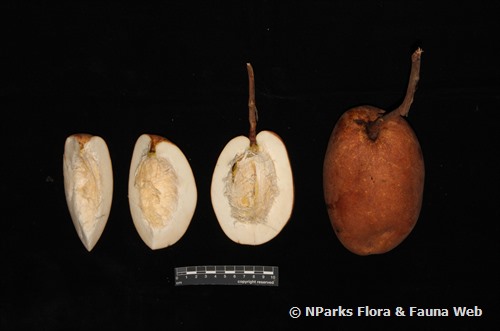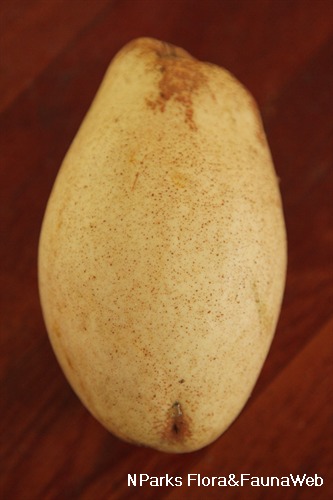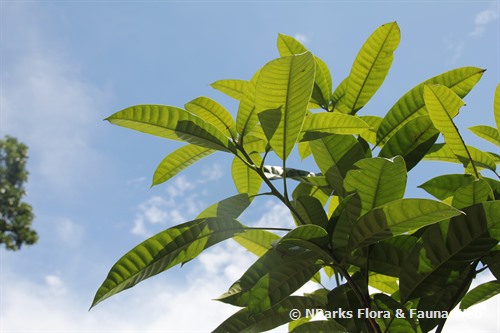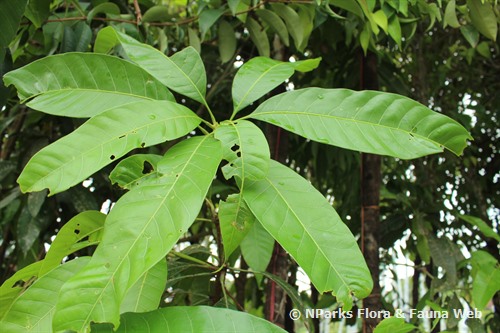
Back
Mangifera caesia Jack
| Family Name: | Anacardiaceae |
| Synonyms: | Mangifera kemanga Blume |
| Common Name: | Binjai |
Name
Classifications and Characteristics
| Plant Division | Angiosperms (Flowering Seed Plants) (Dicotyledon) |
|---|---|
| Plant Growth Form | Tree (Big (>30m)) |
| Lifespan (in Singapore) | Perennial |
| Mode of Nutrition | Autotrophic |
| Plant Shape | Broad / Mushroom / Hemispherical, Irregular |
| Maximum Height | 45 m |
Biogeography
| Native Distribution | Sumatra, Peninsular Malaysia and Borneo. |
|---|---|
| Native Habitat | Terrestrial (Primary Rainforest, Freshwater Swamp Forest, Riverine) |
| Preferred Climate Zone | Tropical |
| Local Conservation Status | Non-native (Spontaneous (Casual)) |
Description and Ethnobotany
| Growth Form | It is a large tree, up to 45 m tall. |
|---|---|
| Foliage | Its alternate, stalked leaves are thick and leathery, about 7.5-41.5 cm long and 2.5-11 cm wide. |
| Flowers | Its violet to lilac flowers are up to 1 cm long each, borne on a branched inflorescences up to 40 cm long. |
| Fruit | Its fleshy fruits are pear-shaped drupes, that ripen to pale to yellowish brown, 10-19 cm long and 5-10 cm wide, containing a single pink seed enclosed with a hard endocarp. |
| Habitat | It grows in lowland primary or swamp forests, and also along riverbanks, up to 450 m altitude. |
| Associated Fauna | Its flowers are insect-pollinated. The fruits are eaten by mammals. It is also the food plant for the mango fruit borer or mango fruit boring caterpillar (Citripestis eutraphera). |
| Cultivation | It can be propagated by seed. |
| Etymology | Mangi, Indian mango, vernacular name for a Mangifera species; Latin caesia, lavender colour, referring to the colour of the flowers. |
| Ethnobotanical Uses | Edible Plant Parts : Edible Fruits Food (Fruit or Vegetable): The young leaves are used to prepare ‘lalab’ (aleafy vegetables dish). The fresh fruits are eaten. The fruits are used to make home-made creamy juices, and eaten as a tamarind substitute. They are also utilised as ingredients in the preparation of ‘sambal’ (a type of chilli-spice mixture), or ‘rojak’ (a fruit and vegetable salad dish). Cultural / Religious: Heritage Tree : There are 4 individuals of Mangifera caesia listed as Heritage Trees in Singapore. They are found all over various parts of Singapore. To find out more about these trees, please visit the Heritage Tree Register. |
Landscaping Features
| Landscaping | It is a widely-known, cultivated fruit tree. It is a tree suitable for large gardens, and parks. |
|---|---|
| Desirable Plant Features | Ornamental Flowers, Ornamental Form |
| Landscape Uses | Parks & Gardens, Riverine |
Fauna, Pollination and Dispersal
| Pollination Method(s) | Biotic (Fauna) |
|---|---|
| Seed or Spore Dispersal | Biotic (Fauna) |
Plant Care and Propagation
| Light Preference | Full Sun |
|---|---|
| Water Preference | Moderate Water, Lots of Water |
| Plant Growth Rate | Moderate |
| Rootzone Tolerance | Moist Soils, Waterlogged Soils (Drains Site), Well-Drained Soils |
| Propagation Method | Seed |
Foliar
| Foliage Retention | Evergreen |
|---|---|
| Mature Foliage Colour(s) | Green |
| Mature Foliage Texture(s) | Leathery |
| Foliar Type | Simple / Unifoliate |
| Foliar Arrangement Along Stem | Alternate, Rosulate / Rosette |
| Foliar Attachment to Stem | Petiolate |
| Foliar Shape(s) | Non-Palm Foliage (Lanceolate, Elliptical) |
| Foliar Venation | Pinnate / Net |
| Foliar Margin | Entire |
| Leaf Area Index (LAI) for Green Plot Ratio | 3.0 (Tree - Intermediate Canopy) |
Floral (Angiosperm)
| Flower & Plant Sexuality | Bisexual Flowers |
| Flower Colour(s) | Purple |
|---|---|
| Flower Grouping | Cluster / Inflorescence |
Fruit, Seed and Spore
| Mature Fruit Colour(s) | Yellow / Golden, Cream / Off-White, Brown |
|---|---|
| Fruit Classification | Simple Fruit |
| Fruit Type | Fleshy Fruit , Non-Accessory Fruit |
Image Repository
Others
| Master ID | 1718 |
|---|---|
| Species ID | 3011 |
| Flora Disclaimer | The information in this website has been compiled from reliable sources, such as reference works on medicinal plants. It is not a substitute for medical advice or treatment and NParks does not purport to provide any medical advice. Readers should always consult his/her physician before using or consuming a plant for medicinal purposes. |
















